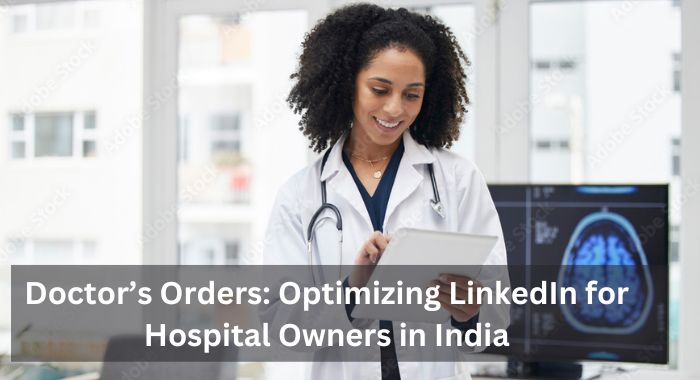
- December 8, 2023
- Shriganesh
- 0 Comments
- Marketing
Doctor’s Orders: Optimizing LinkedIn for Hospital Owners in India
Introduction to the significance of LinkedIn for hospital owners
In the dynamic landscape of healthcare, where digital connectivity plays an increasingly pivotal role, hospital owners in India find themselves at a unique crossroads. Amidst the myriad platforms available, there’s one professional network that stands out as a game-changer: LinkedIn. The significance of LinkedIn for hospital owners extends far beyond a traditional networking site—it is a strategic powerhouse for building brand visibility, fostering meaningful connections, and driving growth in the healthcare sector.
LinkedIn has evolved into more than just a repository of professional profiles; it has become a vibrant ecosystem where hospital owners can engage with a diverse audience. From healthcare professionals and industry influencers to potential partners and patients, LinkedIn offers a multifaceted platform to communicate the essence of a hospital’s mission, values, and accomplishments.
The platform’s robust features enable hospital owners to not only showcase their leadership and expertise but also to actively participate in industry conversations. In a sector where trust and credibility are paramount, LinkedIn provides a digital space for hospital owners to establish themselves as thought leaders, influencers, and contributors to the advancement of healthcare in India.
As we delve into the intricacies of optimizing LinkedIn for hospital owners, it becomes evident that the platform is more than a digital resume—it is a dynamic stage where hospital brands can shine. From crafting compelling profiles that tell a captivating story to strategically engaging with a vast and influential network, LinkedIn emerges as a key ally in the pursuit of elevating a hospital’s brand in the eyes of professionals, patients, and stakeholders.
In this exploration of “Doctor’s Orders: Optimizing LinkedIn for Hospital Owners in India,” we embark on a journey to unveil the transformative potential of LinkedIn. This guide will provide insights, strategies, and actionable steps to empower hospital owners to leverage the full spectrum of LinkedIn’s offerings, ultimately propelling their hospitals to new heights in the ever-evolving healthcare landscape.
Unique Opportunities for Hospital Owners on LinkedIn:
- Professional Networking:
- Opportunity: LinkedIn is a premier platform for hospital owners to connect with a vast network of healthcare professionals, administrators, and industry influencers.
- Benefit: Establishing meaningful connections can lead to collaborative partnerships, referral networks, and access to valuable industry insights.
- Brand Visibility and Thought Leadership:
- Opportunity: LinkedIn offers a platform to showcase the hospital owner’s expertise, accomplishments, and thought leadership in the healthcare sector.
- Benefit: Positioning as an industry authority can enhance brand visibility, attract talent, and foster trust among professionals and potential partners.
- Content Sharing and Education:
- Opportunity: Hospitals can share informative content, such as articles, posts, and updates, to educate their audience about healthcare trends, services, and advancements.
- Benefit: Providing valuable content enhances the hospital’s credibility, engages the audience, and contributes to community education.
- Recruitment and Talent Acquisition:
- Opportunity: LinkedIn serves as a recruitment hub, allowing hospital owners to connect with top-tier talent in the healthcare industry.
- Benefit: Hospitals can attract skilled professionals, showcase their workplace culture, and streamline the recruitment process.
- Community Engagement:
- Opportunity: Hospitals can actively engage with the LinkedIn community through participation in groups, discussions, and industry events.
- Benefit: Building a community presence fosters relationships, opens avenues for collaboration, and demonstrates the hospital’s commitment to community well-being.
Challenges for Hospital Owners on LinkedIn:
- Privacy and Compliance:
- Challenge: Healthcare institutions must navigate privacy and compliance issues when sharing patient-related information or medical content on LinkedIn.
- Mitigation: Hospital owners should adhere to strict privacy guidelines, ensuring that content shared is compliant with healthcare regulations.
- Time and Resource Constraints:
- Challenge: Managing a LinkedIn presence requires time and resources, which may be limited for busy hospital owners.
- Mitigation: Strategically plan content, use scheduling tools, and delegate responsibilities to ensure consistent and effective engagement.
- Navigating a Sensitive Industry:
- Challenge: Healthcare is a sensitive industry, and hospital owners must tread carefully when discussing medical topics or sharing success stories.
- Mitigation: Develop clear communication guidelines, seek legal counsel for content review, and ensure that all shared information adheres to ethical standards.
- Competing for Visibility:
- Challenge: With the abundance of content on LinkedIn, hospital owners may find it challenging to stand out and capture the attention of their target audience.
- Mitigation: Craft compelling and unique content, use visual elements effectively, and leverage LinkedIn advertising to enhance visibility.
- Adapting to Algorithm Changes:
- Challenge: LinkedIn’s algorithm evolves, impacting the reach and visibility of content.
- Mitigation: Stay informed about algorithm changes, adapt content strategies accordingly, and engage with the audience to maintain organic reach.
Leveraging LinkedIn Advertising for Hospital Growth in the Indian Market
A. Overview of LinkedIn Advertising Options Suitable for Hospital Owners in India
- Sponsored Content:
- Explanation of sponsored content to promote hospital updates, achievements, and services.
- Targeting options based on demographics, job titles, and industries relevant to the Indian healthcare sector.
- Sponsored InMail:
- Overview of sponsored InMail campaigns for direct messaging to targeted healthcare professionals.
- Crafting personalized messages to engage decision-makers and build connections.
- LinkedIn Ads:
- Creating display and text ads tailored for the Indian audience.
- Utilizing ad formats that resonate with professionals in the Indian healthcare landscape.
- Dynamic Ads:
- Leveraging dynamic ads for personalized and tailored content experiences.
- Showcasing relevant services and offerings based on the viewer’s LinkedIn profile.
- LinkedIn Video Ads:
- Utilizing video ads to tell compelling stories about the hospital’s facilities, staff, and services.
- Capturing the attention of the Indian audience through visually engaging video content.
B. Crafting Effective Ads to Target Healthcare Professionals, Decision-Makers, and the Indian Audience
- Targeting Specific Demographics:
- Identifying and targeting healthcare professionals and decision-makers on LinkedIn.
- Crafting ad content that speaks directly to the needs and interests of the Indian healthcare audience.
- Compelling Ad Copy:
- Writing clear and concise ad copy that communicates the hospital’s value proposition.
- Emphasizing unique services, advanced technology, or specialized expertise.
- Visual Appeal:
- Using high-quality visuals that resonate with the Indian audience.
- Incorporating culturally relevant images and design elements.
- Call-to-Action (CTA):
- Including a strong and clear call-to-action in every ad.
- Prompting users to visit the hospital’s website, schedule appointments, or engage with specific content.
- Personalization:
- Tailoring ads to the preferences and characteristics of the Indian audience.
- Customizing messages to address specific healthcare concerns prevalent in India.
C. Budgeting and Measuring the ROI of LinkedIn Advertising Campaigns in the Indian Context
- Setting Advertising Budgets:
- Aligning budget allocations with campaign objectives (brand awareness, lead generation, etc.).
- Determining daily or campaign-specific budgets based on the hospital’s goals.
- Performance Metrics:
- Identifying key performance indicators (KPIs) such as click-through rates, impressions, and engagement.
- Monitoring ad performance throughout the campaign to make data-driven adjustments.
- Conversion Tracking:
- Implementing conversion tracking to measure specific actions (appointments, inquiries, etc.).
- Analyzing the correlation between ad engagement and desired outcomes in the Indian market.
- Optimization Strategies:
- Conducting A/B testing to refine ad elements and improve performance.
- Iteratively optimizing campaigns based on data insights specific to the Indian audience.
- ROI Analysis:
- Attributing conversions to specific ads and campaigns to measure the overall return on investment.
- Evaluating the cost-effectiveness of LinkedIn advertising in the Indian context and adjusting strategies accordingly.
Monitoring, Analytics, and Continuous Improvement
A. Importance of Tracking and Analyzing LinkedIn Metrics for Hospital Owners in India
- Strategic Decision-Making:
- Understanding the significance of LinkedIn metrics for informed decision-making.
- Using data to assess the performance of content, engagement, and overall LinkedIn strategies.
- Measuring Brand Visibility:
- Tracking metrics to gauge the hospital’s visibility and reach on LinkedIn.
- Understanding how brand exposure aligns with the hospital’s marketing objectives.
- Audience Insights:
- Utilizing metrics to gain insights into the demographics and behaviors of the LinkedIn audience.
- Tailoring content and strategies based on the preferences of the Indian healthcare professionals and decision-makers.
- Assessing Engagement Levels:
- Monitoring likes, comments, and shares to measure audience engagement.
- Identifying content that resonates and drives meaningful interactions with the Indian audience.
B. Tools and Techniques for Monitoring the Performance of LinkedIn Strategies
- LinkedIn Analytics:
- Leveraging LinkedIn’s built-in analytics tools to track key performance indicators.
- Exploring features such as Page Analytics for detailed insights into content performance.
- Third-Party Analytics Platforms:
- Integrating third-party analytics tools like Google Analytics for a comprehensive view of website traffic originating from LinkedIn.
- Using these tools to assess user behavior, conversions, and other critical metrics.
- Social Media Management Platforms:
- Implementing social media management tools (e.g., Hootsuite, Buffer) for centralized analytics.
- Streamlining the monitoring process and gaining a holistic view of LinkedIn performance.
- URL Tracking Parameters:
- Incorporating UTM parameters in URLs to track the source and effectiveness of LinkedIn traffic.
- Understanding which LinkedIn campaigns and posts are driving the most engagement.
C. Making Data-Driven Adjustments for Continuous Optimization
- Regular Performance Reviews:
- Establishing a routine for reviewing LinkedIn analytics and performance metrics.
- Conducting regular assessments to identify trends, successes, and areas for improvement.
- Content Optimization:
- Adapting content strategies based on high-performing topics and formats.
- Making data-driven decisions to optimize content for maximum engagement in the Indian market.
- Adjusting Advertising Campaigns:
- Iteratively optimizing LinkedIn advertising campaigns based on performance data.
- Allocating budget to well-performing ads and refining targeting parameters for better results.
- Testing and Experimentation:
- Conducting A/B testing on various elements, such as ad copy, visuals, and posting times.
- Using experimentation to identify optimal strategies for engaging the Indian healthcare audience.
- Feedback Incorporation:
- Actively seeking and incorporating feedback from the LinkedIn community.
- Adapting strategies based on audience responses and preferences in the Indian context.
conclusion
the journey through “Doctor’s Orders: Optimizing LinkedIn for Hospital Owners in India” has been a roadmap for hospital leaders to harness the transformative power of LinkedIn in the healthcare landscape. As we reflect on the intricacies explored—from crafting compelling profiles to leveraging advertising and data-driven strategies—it becomes clear that LinkedIn is more than a platform; it is a strategic ally for hospital owners in shaping their digital presence and influencing the future of healthcare in India.
LinkedIn serves as a dynamic canvas for hospital owners to paint their stories, share their successes, and build connections that extend beyond physical boundaries. By optimizing profiles with authenticity and resonance, hospital leaders can lay the foundation for trust, positioning their institutions as pillars of reliability and innovation.
The strategic networking opportunities on LinkedIn offer hospital owners a chance to collaborate, learn, and contribute to the broader healthcare community. Engaging in meaningful discussions, both within and outside the industry, allows for the exchange of insights and the cultivation of a digital presence that transcends the boundaries of traditional healthcare marketing.

